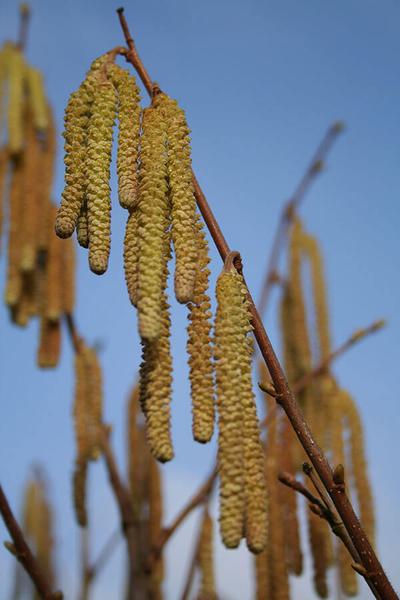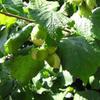Great choice! We're adding your items to the basket and working out what else you might need to plant it.
Hazel Corylus avellana
Example photos only. Size, stem height and habit may vary.
Please contact us for photos of current stock.
Select plant type
Quantity
| Volume Discount | 1+ | 10+ | 50+ | 250+ |
|---|---|---|---|---|
| 40-60cm / Bare root | £2.94 | £1.68 | £1.26 | £1.06 |
| 60-80cm / Bare root | £4.03 | £2.30 | £1.73 | £1.44 |
British Grown – The British Grown logo denotes plants and trees that have been both propagated and grown in the UK. Read more
Product Description
CORYLUS AVELLANA - Hazel
Characteristics
Corylus avellana is the well-known common hazel, native to the whole of Britain and Europe. Hazel grows as a stout shrub or a small tree with several stems growing from the base, rarely more than 6m (20ft) tall. It is often coppiced for firewood and other woodland products, and offers year-round interest in the garden. In winter it has long, yellow catkins; in spring and summer fresh green leaves and in autumn yellow leaves and nuts. Hazel is known as a harbinger of spring, for it is one of the first trees to come into leaf as winter wanes and the days begin to lengthen.
The mid-brown stems have a sheen to them and are spotted with pale lenticels (elongated spots). They make excellent beanpoles. Hazelnuts, meanwhile, are used in the preparation of very fine oil and are incorporated in sweets, chocolates, cakes etc, though those that grow in the wild are more often consumed by squirrels and dormice than humans.
Where to grow
Hazel will grow in a wide range of situations; it is extremely tough and resistant to frost. It does best on damp, fertile soils but will quite happily survive and flourish in rocky places once established. Hazel prefers neutral to alkaline soils and will tolerate quite high levels of shading.
A wonderful hedgerow plant, hazel's pliant stems can easily be laid along the line of the hedge by cutting part of the way into the stem and laying these ‘pleachers’ at an angle, thus forming a strong, stock proof, living fence.
Did you know?
The name ‘avellana’ refers to the Italian village of Avella near Naples, known in antiquity for its hazelnuts.
The common hazel flowers in January, sometimes even before Christmas. The male catkins begin to form in summer and are positioned in the axils of the leaves. They are green in summer, grey-brown when they hibernate and start to blossom bright yellow at first warmth in January. At this stage they resemble waving tails clustered on the bare branches, shining in bright sunlight. The female flowers are also present at this time, but are more modest, appearing as tiny red sea urchins emerging from little buds.
Features
-
Mature Height
- Small - 5-10 metres
-
Spread
- 0-5 metres
-
Shape / Habit
- Shrub Multi-Stem
- Spreading
-
Growth Rate
- Medium
-
Soil Type
- All soil types
-
Sun Levels
- Full sun
- Partial shade
- Heavy Shade
-
Difficulty / Hard to Grow
- Easy
-
Evergreen / Deciduous
- Deciduous
-
Autumn Colour
- Yellow
-
Leaf Colour
- Green
-
Foliage
- Dense
- Early to Leaf
- Large Leaves
- Late to drop leaves
-
Flower Colour
- Yellow
-
Flowering Month
- January
- February
- December
-
Uses
- Screening
- Parkland Tree
- Garden Tree
- Small garden Tree
- City/Urban Sites
- Country/Farmland
- Encourages wildlife
- Good Firewood
- Timber producing
- Wind break
- Bee Friendly
- Edible Fruit/Nuts
- Pollarding/Coppice
- Sound Barrier
- Flower Arranging
-
Hedging
- Native Hedge
-
Native / Naturalised
- Native
-
Season
- Autumn
- Winter
- Spring
- Summer
-
Other Features
- Good at altitude
Aftercare
Pruning Corylus Avellana
Let Corylus avellana grow naturally until settled. Annually remove dead wood and congested stems to the base. Hazel responds well to hard pruning and can be coppiced, however if done regularly this will be at the expense of the golden catkins and nuts.
If growing in a hedge, trim back in March, leaving some flowers and catkins if you want nuts to develop.
What time of year should I prune? Prune in Winter
For the continued healthy growth of your trees, shrubs or hedging it is vital that you follow the advice below.
Watering
The main reason that plants die within 12 months of having been planted is lack of water. It is essential throughout the spring and summer, to give a heavy enough watering to enable the water to penetrate right down to the deepest root level of the tree. In hot dry spells give the equivalent of 2 bucketfuls every three days.
Weed Control
One of the most common causes of lack of water is competition from grass. When trees are first establishing, the grass roots would be at the same level as the tree roots and are far more efficient at taking up water and thus choke the tree. It is vital that for at least 3 years after planting your tree or hedge has a circle or strip one metre wide completely free of grass.
- Mulch mats are an effective way to stop grass and weeds, although they will require a careful eye to make sure they continue to work. After clearing the ground around the tree, firmly fit the mat by tucking the edges into the soil and put a thick layer of bark mulch on top of this. Be careful not to allow the woodchip to touch the stem as it can cause rot.
- Weed killer is very effective, however it is harmful to the environment. Organic weed killers usually do not kill roots. Weed killer needs to be applied each year for the first 3 years, preferably when the tree is dormant, or just once before applying a mulch mat.
- Mowing or strimming is NOT an answer to the problem. Each time you mow, the grass will grow back more vigorously and strimming invariably leads to lacerated trunks.
Staking
If trees are not correctly secured they will rock in the planting pit. Roots not firmly in contact with the soil are unable to take up moisture and nutrients, resulting in die back or death of the tree. Check, particularly after windy weather, that stakes are still solidly in the ground keeping the base of the trunk firm. The purpose of the stakes is to anchor the roots. Flexing in the wind, higher up the trunk, is not necessarily a problem if the roots are firm.
Bellow is list of the correct system to use to secure your trees.
- 40/60, 60/80, 80/100 whips - Unless rabbit/deer problem no need to stake.
- 100/125, 125/150 1.2m Cane and Easi tie.
- 150/175 1.2m square stake and a buckle tie and spacer.
- 175/250, 6/8, 8/10 15L 1.65 Tree stake and a buckle tie and spacer.
- All larger trees. 2 x 1.65 Tree stake and cross rail with 38mm cushion spacer and 1m of 38mm strapping.
Ties
Always use our recommended tree ties or strapping. These are designed and manufactured with the correct amount of give to hold the tree firm without strangling it. They should be checked at the end of each growing season for adjustment as the trunk thickens. Non proprietary materials such as baler twine will cut into the bark and should not be used.
Protection from Animal Damage
Rabbits, deer, sheep, cattle and horses can all potentially damage trees. Ask us for advice on the most appropriate guards for your trees or hedge. Squirrels are also a terrible pest when trees get to about 20ft tall but there is no protection available.
Are the delivery costs the same no matter how many plants I order?
Yes the delivery costs stay the same no matter how many plants you have on your order. They are worked out based on your distance from our nursery and can be found here.



